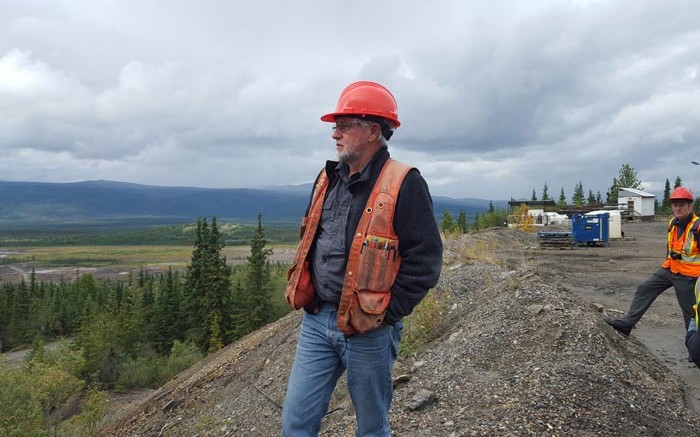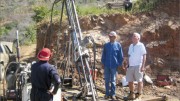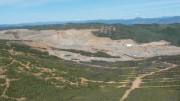KENO CITY, YUKON — There’s a wealth of history in the Yukon’s Keno Hill mining district, and Alexco Resource (TSX: AXR; NYSE-MKT: AXU) is out to prove there’s a lot of silver left to discover across its large land package, 330 km north of Whitehorse. The company shuttered underground operations at its Bellekeno mine two years ago, but new discoveries just might inject life into the famous region in the southern Klondike.
Driving through the abandoned mining town of Elsa on the way to Alexco’s site offices, it’s evident just how prolific the historic United Keno Hill mine must have been at its peak. The dilapidated cottages and apartment buildings observe the old township through blank windows, as a mud-stained tour van takes a sharp turn past a crumbling elementary school and community centre.
In the 1950s, Elsa hosted the second-largest silver producer in Canada and the fourth-largest in the world. According to the Yukon government, between 1913 and 1989 Keno Hill produced more than 217 million oz. silver and hosted 35 mine sites.
The history of the district plays a role in Alexco’s story, since it acquired a 235 sq. km land position surrounding Keno under an agreement with the government, which requires it clean up large-scale environmental liabilities left behind by previous operators.
The company is a bit of an anomaly in the mining industry, since it isn’t strictly focused on exploration, development and production. Alexco also operates an environmental consulting division that services clients across a number of sectors, including: mining, oil and gas, transportation, government and First Nations.
President and CEO Clynton Nauman explains during an interview that the environmental side of Alexco’s business developed from management’s previous experience working with major companies like Rio Tinto (NYSE: RIO), which led to expertise and connections for remediation, permitting and social licence.
“We’re a mining company in one regard, but we’re also operating a profitable environmental division with a large — and growing — group of professionals who give us a real strategic advantage,” Nauman says. “We have technologies we’ve applied, and as a result we’re recognized by all levels of government on the environmental side. Keno Hill is a great example of how building those relationships can result in great opportunities in the mining business.”
In fact, Alexco’s environmental group has shouldered most of its cash generation during the downturn in the mining sector. The company reported revenue from environmental remediation totalling $15 million in 2014 — with a 33% profit margin — and estimates it has $100 million in backlog environmental contracts, including work at Keno Hill.
Alexco recently completed a contract with the U.S. Environmental Protection Agency involving an interim water-treatment facility at the Gold King mine near Silverton, Colo. The abandoned operation was the site of a high-profile spill in August that impacted the Animas River.
“Few people are buying our stock based on this profitable environmental business that is, in essence, subsidizing our investment in high-grade silver mining,” Nauman says.
“The plan is two build up both businesses alongside each other, but eventually … we’ll be forced to split things up. It will advance to a point where we’ll be forced to capitalize each unit separately, because our investors will be involved for different reasons,” he adds.
But the cash made from the environmental division has helped Alexco stay capitalized in tough markets, and invest in drilling and mapping at Keno Hill. Vice-president of exploration Alan McOnie says that the company inherited a “metric ton” of historic data when it picked up the property, and that has proven vital, since the region’s mineralization tends to be under cover, with “almost zero” outcrop.
Keno Hill is classified as a polymetallic silver-lead-zinc vein district, with characteristics analogous to the Kokanee Range in B.C.; and the Coeur d’Alene district in Idaho. Common characteristics include proximity to crustal-scale faults — affecting thick clastic metasedimentary rocks — and intrusion of felsic rocks that may have heated the hydrothermal system.
Alexco has drilled 165,000 metres at Keno since acquiring the land in 2010. Underground exploration work at Bellekeno during its two years of production helped the company get a handle on the structural controls and faulting in the region, which resulted in the discoveries Flame & Moth and Bermingham.
“Flame & Moth is pretty central when we talk about the Keno region, but it is also under cover, so it was relatively untouched historically, outside of a bit of prospecting,” McOnie explains while standing outside Alexco’s mill building.
The proposed portal for Flame & Moth is mere steps from the mill site, and it seems a stroke of luck that the company didn’t build any infrastructure directly over the discovery.
“It’s extremely important to understand how the deposits form, and so we’ve tried to identify the fault systems, and used the old mining data to determine structural controls. The host rock is significant in that regard, and we have a lot of information from resource drilling and production at Bellekeno that has allowed us to come up with more definitive exploration models,” he continues.
Alexco has completed 176 drill holes over 41,000 metres at Flame & Moth since making the discovery four years ago. Mineralization comprises multi-phase quartz and siderite veining, developed within a broad host fault structure. Locally it contains massive galena, sphalerite, pyrite and pyrrhotite, with associated silver sulphosalts, arsenopyrite and chalcopyrite.
The company released an updated resource at Flame & Moth in April, which is based on the north- to northeast-striking, moderately southeast-dipping Flame vein that is divided into two segments by a northwest-striking fault. The Flame vein — outlined in the hanging wall of the Mill fault — has been designated as the “Lightning zone,” and the footwall portion termed the “Christal zone.”
The combined deposit hosts indicated resources of 1.6 million tonnes grading 506 grams silver per tonne, 0.43 gram gold per tonne, 1.9% lead and 5.4% zinc. Contained silver is estimated at nearly 27 million oz.
“We’re really positioning Keno for the restart of production. The time since our shutdown has been spent on a lot of engineering work and studies based on a promising discovery,” Nauman says. “We’re excited, because Flame & Moth is amenable to much higher capacity than we’d run previously, without compromising our high grades.”
Meanwhile, the Bermingham deposit was discovered in 2014 after Alexco cut the “best intercept ever drilled” at Keno when it assayed 6.4 metres of true width grading 5,667 grams silver in hole 14-537. McOnie points to the discovery on the top of nearby Galena Hill, which hosts a historic open pit. Alexco completed 3,000 metres at the target this year.
“We were following up on an intercept we had late last year to see if we could understand the controls and how extensive that mineralization might be, because we see a lot of potential there,” McOnie adds.
Bermingham hosts 377,000 indicated tonnes grading 430 grams silver, 1.6% lead and 1.7% zinc. Contained silver is estimated at 5.2 million oz.
Alexco released results from drilling on the vein in September, with highlights including: 4 metres grading 7,462 grams silver in hole 15-580; 4.8 metres of 2,357 grams silver in hole 15-582; and 2.4 metres averaging 3,774 grams silver in hole 15-
583.
And Alexco remains well capitalized to pursue more discoveries next year, while awaiting a bounceback in silver prices. The company hopes to develop a mine plan that will drop its operating costs down to US$15 per oz. silver.
Alexco reported cash and equivalents of nearly $6 million at the end of September, and closed a $4-million hybrid private placement in early December. The company issued 5.7 million flow-through shares priced at 53¢, and 2 million hard shares priced at 48¢. Alexco shares have traded within a 52-week range of 34¢ to 81¢, and closed at 46.5¢ per share at press time.
The company has 69.5 million shares outstanding for a $32.3-million market capitalization.
“The key concept everyone who comes to visit us should take home with them is the overall scale of the district. We’re talking about a mining trend that runs over 30 km, and covers a huge area,” Nauman says. “We’ve now done much more drilling and have a greater understanding of the geology, so when we go back into production, we’ll do so at a much higher throughput, and subsequently produce even more silver.”






Be the first to comment on "Site visit: Alexco finds silver lining at Keno with Flame & Moth"